5 minute read
By Jess Brooks
On a bright September afternoon in Dorset, I am in a pair of green waders in a gravel-bottomed tree-lined stream. The rain has cleared, the gnats have come out and the shrill squeak of a kingfisher pierces the gentle sound of shallow water.
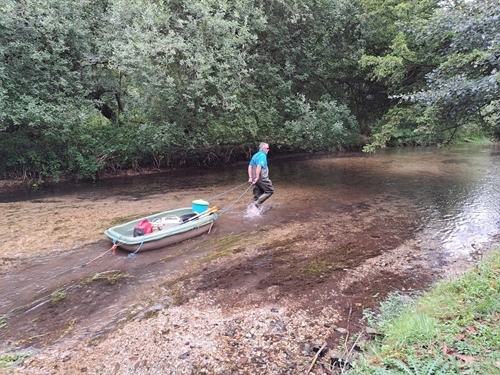
Luke Scott, Fisheries Scientist, towing the electrofishing survey boat – note the half-eaten remains of water crowfoot, for which swans are responsible
I’m with Rasmus Lauridsen and Luke Scott from the Trust’s fisheries team, catching young salmon and trout in a tributary of the River Frome, an internationally important chalk river. These are the final days of a gargantuan annual fish tagging project, one of the largest of its kind in the world, and despite this long and exhausting period of fieldwork the humour hasn’t died yet. “LOOK! The boat is floating!” says Luke theatrically. This year the water level is so depleted that in most areas of the river the boat would have been better off with wheels.
In late summer every year since 2005, a delegation of GWCT staff, students, volunteers and curious visitors gathers at the Fisheries Research lab in East Stoke, Dorset. They are also joined by project partners Cefas (Centre for Environment, Fisheries and Aquaculture Science). Two teams are sent out daily for three weeks to various stretches of the River Frome and its feeder streams. By the end of September they aim to have netted, tagged and released 13,000 young salmon and trout, called ‘parr’. To visualise just how many that is, imagine tipping four big bags of frozen peas on the floor, and every pea represents a fish.
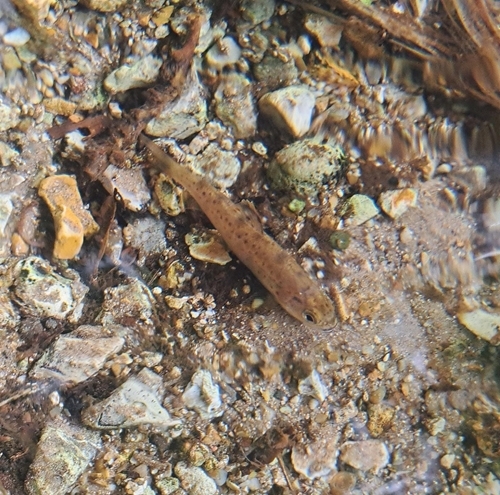
A newly tagged trout parr, released back into the river where it is superbly camouflaged
These parr began life as a pink egg in a gravelly scrape on the riverbed called a ‘redd’. Eggs laid in autumn hatch into alevins in spring, which become fry, then grow into parr. Parr have strong barred markings for camouflage. They need habitat that offers shade and shelter, an abundance of prey, and good flow diversity – which in most lowland rivers is generated by aquatic plants.
Tagging a significant proportion of the salmon and trout parr in autumn is a key component of the team’s ability to monitor and estimate fish growth, numbers and movements. The River
Frome is one of five rivers in England and France studied in depth as part of the wider EU-funded SAMARCH project (Salmonid Management around the Channel), which aims to understand and address declines of migratory salmon and trout in the English Channel.
Today, we are surveying a stretch of river bordered by military training grounds on one bank, and damp floodplain pasture on the other. The occasional boom of tank artillery punctuates the peace. Four of the team are in the river catching the parr using a method called electrofishing, and the other three are on the bank in a riverside mobile laboratory, processing and tagging them.
Rasmus is in front with a net and the electrofishing wand (a bit like an aquatic metal detector); I am holding a second net trying to ignore the gnats and my squelching wet sock; Luke guides the boat which holds a heavy petrol generator and electrofishing power unit, and French student Antoine is holding the fish collection bucket.
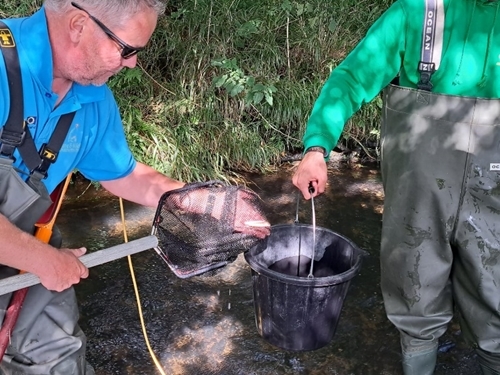
Luke pops a parr in the collection bucket, soon to be tagged and re-released
Today we are focussing on salmon because the target quota of 3,000 trout has already been reached. When Rasmus pulls the trigger on the wand and sweeps it through the water, it emits an electric current to stun the fish nearby. Curiously, the salmon parr swim towards the wand before they are incapacitated and can be caught easily with a hand net.
Others involuntarily thrash around or dart off like an arrow and take a great deal of skill and focus to catch. We see lots of brown trout, minnow and bullhead, and occasionally pike, stone loach and eel. Sometimes there are dozens of fish from multiple species and similar sizes writhing around and drifting all at once, with our quarry in amongst them – but Rasmus expertly singles out the salmon and plunges the net in.
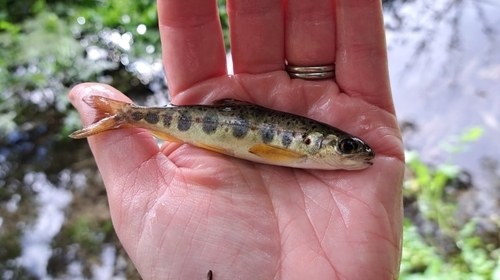
A salmon parr – note small mouth and broad body markings
I am frequently flabbergasted at the speed and accuracy with which they are identified and seized. And Luke – who is towing the boat today but a formidable electro-fisherman himself – peers over my shoulder to confirm the ID whilst they’re still underwater. I swoop up the fish and he’s right – it’s a trout, not a salmon. “But you only saw a flash of a belly!” I exclaim. “That’s all it takes when you get to this age”, says Luke, pointing out his 20 years of experience versus my 20 minutes. Meanwhile, Rasmus gives a sudden lurch and starts bounding across the river in pursuit of a getaway. The team really want every last salmon – they are passionate about getting complete, robust data.
So good was their camouflage, I could hardly see some of the fish in the margins and dark silty pools. Salmon and trout have something in common with chameleons – Luke explained how they can change the pigment in their skin depending on how much sunlight is present. Fish lurking in dark areas of the river can be almost black in colour, but when they are transferred into a brighter environment – such as a yellow bucket - their skin can lighten up within minutes.
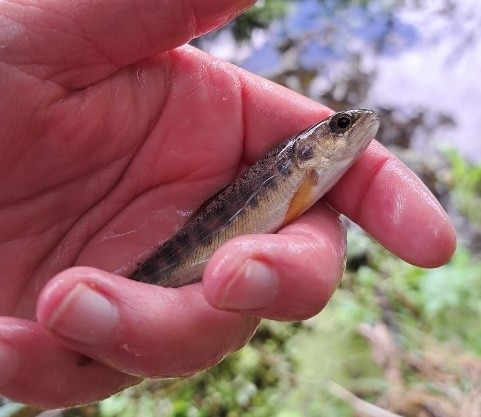
A trout parr – note bigger mouth and less defined markings
With their decades of experience the team are prepared for most eventualities, with an array of trusty tools and backups of all equipment. We come across a big tangle of willow that has been felled across the river, blocking our progress. Large woody debris can be a good thing, creating flow diversity, but this felling was a bit reckless and not particularly beneficial. Out comes a hacksaw and, after a bit of impromptu habitat management, we push through.
This year’s drought is on everyone’s minds. The team are troubled by the critically low water level, often only a few centimetres deep with frequent newly-exposed beaches of gravel and cobbles. Low flow reduces the amount of aquatic habitat and increases the concentration of harmful pollutants, but there is another problem: shallow water heats up quickly. Luke recalls the water reaching 19°C in August; chalk streams are aquifer-fed and should normally have a temperature of around 11°C, providing the cool, clear, oxygen-rich environment all year round that a rich diversity of chalk river wildlife depends on. The impact of this drought won’t be fully known until next year’s data is collected.
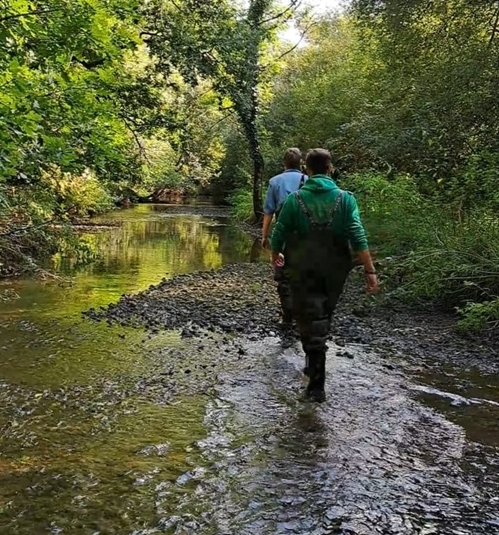
The water levels are incredibly low
Later in the day we interrupt a flock of swans and cygnets grazing on river plants, and they glide off in a huff. Swans like grazing on water crowfoot, which is a feathery-leaved, white-flowered aquatic plant related to the buttercup that is incredibly beneficial to salmon parr. Low flow means swans can easily stand on the riverbed and munch it up. In areas which should be thick with this life-sustaining plant, I saw only tattered strings and stubs. Combined with all the other stresses on salmon rivers – such as climate-change-induced extremes in temperature and flow, weirs, and pollution – this is another toll of the bell.
It is soon our turn to process and tag the parr, whilst the other half of the team take over fishing. The salmon we have caught are lowered into a bucket of water drugged with a safe sedative. Most of the fish are around six months old, and they’d fit in a sardine tin. It takes a dextrous pair of hands to measure and weigh a slippery 10cm fish, insert a rice-grain-sized passive integrated responder (PIT) tag, mark their adipose fin, and then lift a few scales – all within a matter of seconds. Antoine and I are labelling the scale sample envelopes and entering the data into a laptop. It requires intense focus to keep up with Rasmus, and scrambles our brains after a couple of hours! The fish then recover in an oxygenated bucket before being released back to the same stretch of the river.
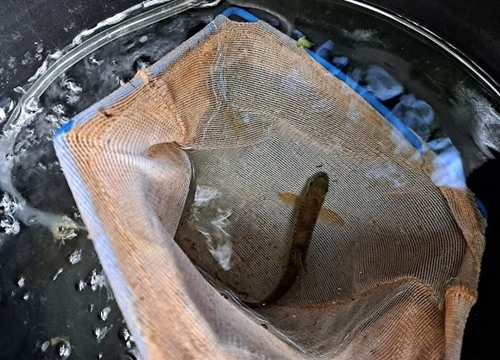
Lifting a parr from an oxygenated bucket
Rasmus spots some oddities in our catch. He shows me a hybrid salmon-trout parr, which is relatively uncommon. Later he lifts out a 15cm male salmon which has a tell-tale soft belly. “Feel here, this one is precocious. It means he’s cheating!” This one has reached sexual maturity in the river before undertaking the perilous marine migration. He may take his chances spawning with adult females, whilst returning males – many times their size – try to end these small sneakers’ endeavour abruptly.
A PIT tag stays with the fish for life and has a unique code. “This acts as an individual identifier so that we will know Bob, Amanda and John when they swim past the detector antennae,” says Rasmus. They will next be detected on the River Frome at East Stoke as bigger, silvery ‘smolts’ on their migration out to sea. Then, after a year or more feeding and growing on a round trip to the North Atlantic, the now-adult salmon are detected again as they complete the astonishing feat of returning to their birthplace to spawn.
Data from this extraordinary tagging effort has resulted in dozens of scientific publications as well as actively informing salmon management and conservation. Unfortunately the 2021 data shows that the number of smolts leaving the River Frome was down by 30% compared to the 10-year average. The International Council for Exploration of the Sea estimates that numbers of returning adult salmon have declined by 70% since 1970, and the Missing Salmon Alliance (of which GWCT is a founding member) gravely warn that the species could disappear in our lifetime.
When the 2022 parr tagging effort is complete, it’s a big relief for the Fisheries team, who all look forward to a breather after three weeks of physically and mentally draining fieldwork. Two of the student volunteers celebrate by cracking open and drinking an ancient can of beer that Luke found buried in the river and thoughtfully donated. The less brave (or more sensible) of us watched on incredulously, but apparently it was as good as the day it was brewed!
Their cause for celebration is fleeting however, because the mandate to save the Atlantic salmon – and the river environment on which they depend – remains. I can only hope that the characterful, hugely knowledgeable and dedicated fellowship of scientists at the Fisheries Research centre does not have to study these fish to extinction.
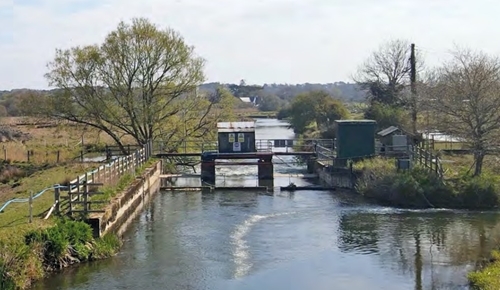
PIT-tag detectors and adult fish counter on the River Frome, at GWCT’s East Stoke Fisheries Research centre (drone photograph by Olly Dean)